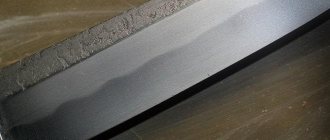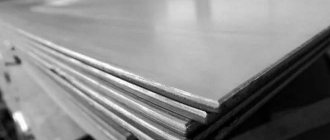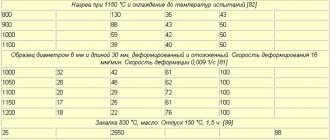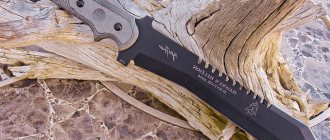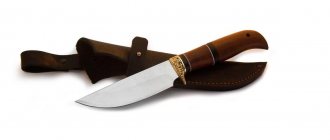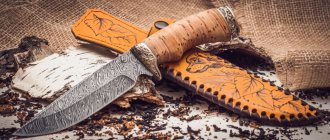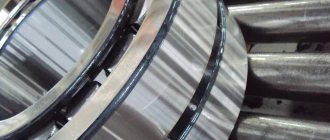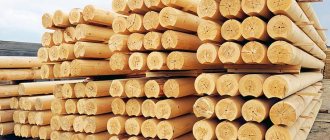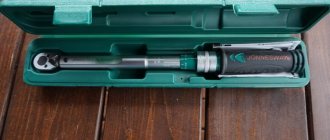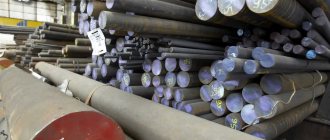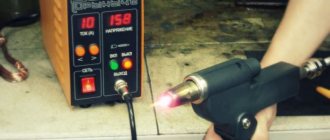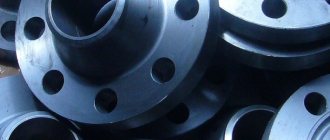The production of tourist knives is constantly being improved, and metallurgical plants are coming up with new alloys. They make the cost of the final product lower, and the quality of such knives is not inferior to imported analogues. In Russia, samples made of 95X18 stainless steel are widely used for knives, the pros and cons of which depend on the purposes of purchase and operation by each individual user.
Knife Beaver.
Chemical composition of steel 95Х18
Stainless steel 95X18 contains a number of chemical elements that determine its physical and chemical properties.
Forged steel 95X18 surpasses many other alloys in strength and hardness, reaching 57-58 HRC. This is due to its high carbon content.
The basis of the alloy material, like any ferrous metal, is iron, of which in the classical formula there is at least 78%.
| C, % | Cr, % | Mn, % | Ni, % | Si, % | Ti, % | P, % | S, % | Cu,% |
| 0,9-1 | 17-19 | 0,8 | 0,6 | 08 | 0,2 | 0,03 | 0,25 | 0,3 |
Explanation of markings
The percentage of carbon present in the alloy is 0.9-1%, so for convenience, the average value is indicated - 0.95, which is included in the marking.
The letter X between the content of constituent elements means the presence of an alloying component - chromium. The number 18 indicates its percentage in the alloy. In fact, this value varies between 17-19%.
Folding knives “Zubr” contain 0.95% carbon and 18% chromium.
Improving material properties
To increase the durability and anti-corrosion properties of welds and reduce the ability of grain formation in the lattice, carbide-forming elements are introduced into the composition. An additional reduction in grain size occurs when microdoses of surface-active components are included in the alloy, the most effective of which is cerium. Such microalloying with rare earth elements turns out to be useful only with carefully dosed administration and in compliance with the technology.
The following impurities affect the reduction in the cold capacity of steels:
- nitrogen and carbon - with a total amount of these impurities ≤ 0.01%, the strength and performance of welds in ferritic steels with a high chromium content significantly increases;
- oxygen, phosphorus , to some extent sulfur , silicon and manganese also reduce the cold capacity of the material.
If we talk about the requirement of purity of ferritic chromium alloys, then compliance with this quality indicator leads to increased accuracy in technological processes and smelting. Anti-corrosion resistance against destruction of intercrystalline compounds is achieved with a nitrogen and carbon content in a total ratio of 0.01−0.015%. If this normalized indicator is exceeded, then additional stabilizers are used in the form of niobium and titanium additives.
The increased brittleness of ferritic steels occurs due to a violation of the temperature processing technology; sometimes, at a range of 540–860˚С, their middle phase of solid solution is released and “475˚С brittleness” appears. Such types of increased fragility of the material are reversible and are removed with proper thermal exposure.
To improve surface qualities, it is important to bind silicate inclusions with deoxidation products; for this purpose, the method of alloying with silicon is used. The method prevents pitting corrosion from appearing on the surface due to the action of silicon in the form of a passive film.
Mechanical loads for metal are chosen strictly for their intended purpose, since increased fragility provokes destruction of the edge and the appearance of curvature of the blade if objects are used incorrectly. Despite the anti-corrosion qualities of the metal, prolonged exposure of blades to a saturated salt solution leads to a violation of surface integrity and has a bad effect on the performance of the product. In most cases, the 95x18 specifications are used for the manufacture of parts that are not welded during installation.
Classification of foreign analogues
Marking 95Х18 is used exclusively in the countries of the former CIS. Foreign analogues differ in their percentage characteristics of the content of key elements, and accordingly, the labeling in other countries is completely different.
Alloy designations from foreign importers:
- in the USA - 440C, 440B;
- in Germany – X105CrMo17, X102CrMo17;
- in Poland – H18;
- in Japan - SUS440C.
Thus, the alloy closest in composition to the Russian one is cast in Poland. Japanese manufacturers use chrome steel from the USA as the basis for their knives.
The shape of the knife is no less important
The design features of cutting products complement and increase functionality. They correctly distribute the load and make using the knife easy and convenient. When making a blade, great importance is attached to the shape, size, method of sharpening the edge and the method of attaching the handle. Each of these items has more detailed fixtures. They increase convenience and enhance the artistic value of the product. There is a direct dependence on the thickness of the blade and the quality of cutting. The thinner the blade, the better it is for small jobs.
Physical and mechanical properties of the alloy
High strength and wear resistance make alloy steel 95Х18 one of the most popular in metallurgy. The maximum blade hardness on the Rockwell scale can reach 62 HRC. The alloy goes through the stages of hardening and tempering under strict adherence to the temperature regime, which determines the high level of strength.
The peculiarity of the alloy is that if it is “overexposed” in crucibles and the rules of heat treatment are violated, then the composition cannot be changed and its main advantages will be lost during forging.
Knives made of damask steel are undemanding in sharpening, since blades made of 95X18 alloy are slightly dull. Such chrome-plated knives can be sharpened even on a stone or a diamond-coated stone with a grain size of 100/80 and 50/40.
Damask steel knives.
Forging treatment
The presence of chromium in its chemical composition puts high-strength steel in the category of corrosion-resistant or stainless steel. In addition, 95x18 steel is intended for forging. For any metal structure, this procedure is a “treatment” for many diseases, the most common of which are microcracks, filling of pores with harmful elements of hydrogen, oxygen, and, of course, vacancies (a place not occupied by an atom that forms a cavity). In addition to “diseases,” forging helps to get rid of chemical and dendritic segregation and to “comprise” all molecules more tightly. With such rigid structuring, the metal grain is refined. This allows you to increase ductility without reducing strength. After this, steel 95x18 has characteristics that can withstand heavy loads even in bending.
Effect of alloying additives
Steel 95X18 is a favorite not only among professional knife makers, but also among ordinary users. The “Beaver” damask knife model has a comfortable grip and a simple design.
The maximum strength of “Beaver” 60-62 HRC is achieved due to the influence of the main alloying additive – carbon. Additional components, such as copper, manganese, nickel, phosphorus, have a smaller share in the composition of this ferrous metal - only 3-5%.
But these elements are extremely necessary to support and activate the protective properties of chromium and improve the quality characteristics of the finished product. Chrome gives anti-corrosion and antibacterial properties to knives made of steel 95X18.
Knife model “Beaver” made of steel 95X18. .
Steel 95x18 characteristics for knives reviews
Steel 95x18 for the production of knives has established itself as the optimal material that meets the main requirements for the manufacture, technical and operational characteristics of this type of product. This choice of knife manufacturers is due to the excellent combination of the necessary properties of steel.
Advantages and disadvantages
Despite its demand and undeniable advantages, chrome steel 95X18 also has weaknesses, which is why it may be inferior to other domestic alloys . In some cases, a substitute for 95Х18 can be steel Х12МФ, which is an analogue of American steel D2.
The strength of this alloy is also increased to 60-62 HRC, and the blade made from it is wear-resistant and multifunctional in use. Buyers often ask which steel should be chosen: 95X18 or X12MF. This question should be based on the frequency of use and purpose of the knife.
X12MF steel is a general-purpose alloy, from which not only knives are produced, but also other metal products: gears, rollers, dies and other parts that do not require high strength indicators.
A knife made of X12MF alloy is less resistant to strong mechanical stress. In addition, it becomes covered with dark spots and stains after just a few uses when in contact with fruits, vegetables and meat, and also does not tolerate careless treatment. This leads to a quick loss of the attractive appearance of the product, but has almost no effect on the cutting properties of the blade.
Steel 95X18 is subjected to a qualitatively different processing technology, as a result of which it does not lose its bright metallic shine and production gloss under any conditions of use. An additional and most important advantage of this steel is its availability: at a low price, the quality of these knives is not inferior to imported brands.
Its disadvantages are due to the same production features:
- the sharpness of the blade of stainless chrome steel 95X18 is slightly lower than that of other alloys;
- the cutting depth of the knife is relatively small;
- the blade cannot withstand strong fracture loads with a spine thickness of 4 mm.
This knife is chosen if you plan to use it infrequently or only in rare cases when you plan to go outdoors or hike. After a long period of inactivity, it will not rust and will look like new.
If a knife is needed for daily use, you should choose the multifunctional cutting base for X12MF knives, which shows better results in faster and deeper cuts.
Knives made of steel X12MF and 95X18.
Basic indicators of metal and its properties
The material belongs to the class of steels that resist corrosion well, and therefore is used for the manufacture of durable structural elements, which during operation are subject to special requirements in terms of wear resistance, operation in an aggressive environment, and at high temperatures. The industry supplies the market with long products in the form of calibrated, shaped or ground rods, strips, silver bars, forged blanks and forgings.
Mechanical characteristics
Incorrect hardening and untimely tempering lead to the appearance of negative characteristics. 95×18 steel belongs to the martensitic class; it is strengthened during the hardening process; after annealing, a ledeburite structure is obtained with a slight excess of carbides that differ morphologically:
- the shape of primary carbides is elongated along the direction of forging or rolling, they appear after the liquid phase;
- Along the edges and in the body of the initial austenic grains, secondary small carbides are released upon cooling.
With increasing temperature during hardening, the number of retained austenites reaches a maximum value, the hardness gains extreme characteristics, the values of which fluctuate in the range of 57-58 HR. Such values in steel are obtained when hardening at 1050˚C; for comparison, a hardness of 26 HR is obtained at a temperature of 1250˚C .
Mechanical indicators:
- steel 95×18 has a specific gravity of 7.75 tons per cubic meter;
- in MPa, the hardness of the material ranges from 230−245;
- density indicator - 7.75 × 10 3 kg/m3;
- thermal conductivity of metal - 24.3 W;
- specific heat capacity of steel at 20˚С - 0.483×10 3J;
- the electrical resistivity parameter is 0.68×10 6 Ohm. m.
Basic processing parameters
Working with metal requires the use of the correct technological techniques to create the material in accordance with accepted GOST standards in Russia. For the production of long or rolled steel, the method of rolling or reforging the original billet is used at high temperatures, followed by gradual cooling. Deformation occurs in the range of 1125−900˚С, followed by slow cooling or maintaining a temperature of 750˚С with further cooling.
The hardening process requires oil with a temperature of 1000 to 1050˚C. Tempering is done at 200−310˚С, if you increase the values to 490−500˚С, then the corrosion resistance sharply declines as a result of an increase in the number of carbides. If, after hardening at temperatures up to 350˚C, table salt in the form of a 3% solution is added to cooling water, the material will obtain satisfactory anti-corrosion qualities.
For annealing, the maximum temperature is set in the range 880−910˚С. If a profile with a cross section of up to 700 mm is processed, then recrystallization technology with further tempering is used. The temperature during cold processing is 70−85˚С, forging is done at 1195˚С at first, gradually raising the temperature to 845˚С, then maintained at 750˚С, cooled.
Features of the material
Despite the fact that metal alloying occurs in the most economical mode for production, 95×18 steel in some cases is not recommended for use for the manufacture of structural parts and elements due to some features:
- increased ability to form grains when heated;
- the resulting large grains due to the absence of polymorphic processes during technological processing cannot be eliminated by thermal action;
- the cold resistance of welded joints made of this metal and the steel itself is limited to a threshold of -40˚С;
- low formability in the process of plastic cold deformation, this is due to the small number of slip planes involved in the structural lattice.
Production technology
During production, steel 95Х18 goes through 4 main stages of processing:
- forging;
- burning;
- hardening;
- vacation.
Initially, steel sheets are subjected to mechanical deformation by forging hammers, after which the workpieces are cooled. The key condition for production technology is a regulated hardening regime, violation of which can lead to excessive fragility or softness of the metal.
During hardening, the raw material is heated to a critically high temperature and quickly cooled in oil or water. The level of hardness of the final product here is determined by the grain size of the authensite contained in the metal lattice structure. The diameter of these particles increases as temperatures increase.
Most often, 95X18 is supplied to factories in the form of slabs - flat rectangles, and the blade itself is made from varietal blanks made from special rods. Knife forging is carried out cold or hot, manually or using forging hammers.
Without manual labor in a forge, these technological processes are not yet possible, so you should purchase knives made of 95X18 steel only from reputable manufacturing factories. Counterfeits from handicraft forges, which are sometimes found on the market, may not differ in appearance from the original knife. Caution is necessary, since only a product made from raw materials with the characteristics declared according to GOST will serve for a long time.
Steel forging process.
Areas of use of steel 95x18
The characteristics and application of 95x18 steel are closely interrelated. Durable, resistant to loads and aggressive influences, the alloy is in demand not only for the manufacture of specialized knives.
Knife made of forged steel 95×18
The metal is actively used in aircraft and mechanical engineering. The list of the most popular products for the manufacture of which this alloy is required by industrial enterprises includes bushings, bearings, and various axles designed for increased operating loads.
The modern range of industrial products made from steel 95x18, regulated by GOST, includes:
- calibrated and ground rods;
- long and shaped rolled products (usually in the form of cylindrical billets);
- steel strips.
Forged products in the form of blanks are also in stable demand in the domestic market.
Heat treatment conditions
According to GOST, martensitic, as it is marked by manufacturers, raw materials are continuously poured into blanks and rolled out in a hot converter shop at a temperature of 750-950°C.
The temperature conditions at different stages of processing are as follows:
- The maximum temperature for heating steel to a state of crystal lattice instability is from 900 to 1125°C.
- The temperature when cooling the workpieces is up to 450-650°C.
- The temperature during tempering and returning the metal lattice structure to a stable state is 150-650°C.
The procedure for smelting steel 95Х18.
Universal steels
The characteristics of a steel object are determined by its geometry, but to a greater extent by the structure of the metal, which, in turn, depends on its composition and the necessary thermal, chemical and mechanical processing. It is the combination of these criteria that explains such a huge number of steel grades and finished products. Since there are different priorities regarding the characteristics of metal products (sometimes only strength is needed, and sometimes only ductility), the steel is initially selected according to its chemical composition, and receives its final properties through further processing.
Edge formation
The cutting edge of the knife gets its shape in two passes. The first pass allows you to obtain only preliminary dimensions, the second – more accurate ones. Immediately after the first tempering, final machining is carried out. The blade is ground on the machine to the required size. Steel 95x18, which is heat treated in four stages, takes on its final properties after the second tempering, during which all stress is removed - and the metal becomes as ductile as possible. To do this, the finished blade is kept at a temperature of 150 degrees for 1-2 hours. Cooling takes place in air. To decorate the blade with unique patterns, acid etching can be carried out.
